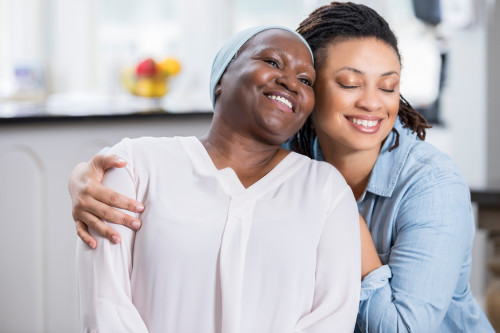Danielle Nicosia wishes people would stop saying she’s lucky because she got “the good cancer.” In 2012, the New York City native, then 26, was diagnosed with Stage II thyroid cancer—“good” thanks to its high survival rate. She has had four recurrences, requiring multiple surgeries and two unsuccessful radioactive iodine treatments over the past seven years. It turns out she has a gene mutation that means her cancer “can continue to come back at any time,” she says.
Now living in Florida, where she moved in 2017 to escape the cold and New York’s high prices, Nicosia experiences debilitating pain and fatigue, allergic skin reactions caused by the radioactive iodine and numbness on the right side of her body that has persisted since her last surgery a year ago. She also suffers from posttraumatic stress disorder and was recently diagnosed with Crohn’s disease. Permanently disabled and unable to walk more than a few steps at a time, she gets around in a wheelchair and is training Dory, a black Lab service dog, to help her out. She also joined IHadCancer.com, a support group she says saved her life by connecting her with others, lifting her spirits and providing a kind of huge, caring family.
But even for a self-described optimist like Nicosia, it’s hard to cope. “I just push through every day. I breathe, I blog, I say, ‘I have to keep in mind that I’m going to be OK,’” she says. When asked what would make life better, she mentions improved pain medicine (“Nothing works. Why don’t they come up with something else?”), more affordable care (“My boyfriend and I are living on one income. The co-pays, the hospital bills—I’m afraid to go to the hospital because it’s so much money!”) and more supportive care (she’s now receiving coordinated care at the Mayo Clinic’s campus in Jacksonville but previously found herself being shuttled from doctor to doctor).
It’s a litany of woes that many cancer survivors can relate to—too few treatment choices, debilitating side effects, unaffordable medical bills, uncoordinated or inadequate support. Although cancer researchers have made major strides in recent years and more people than ever are surviving longer, these advances haven’t always been accompanied by improvements in quality of life.

Istock (Model(s) used for illustrative purposes only)
That’s the subject of this special Cancer Health report—and it’s the next big challenge for the cancer community. Finding effective new treatments is absolutely essential—after all, there’s no quality of life if there’s no life. But it’s not enough. To truly serve the interests of the more than 15 million Americans who have had cancer, to help them enjoy more life with less suffering, will take more. It will require changes in how we develop drugs, how we listen to patients as treatments are developed, how we pay for astronomical costs and how we support people during and after—including long after—a cancer diagnosis.
It all comes down to quality of life. It’s about well-being—physical, of course, including managing pain and fatigue, but also psychological, social and spiritual. Making quality of life more central to cancer care means paying more attention to the experiences of people with cancer, from diagnosis through treatment and survival. It means taking care of the whole person.
Here are some key issues, with recommendations for ways the American system of cancer care has to change and tips on how individuals living with cancer—and their caregivers—can advocate for the best quality of life.
Next: Side Effects.
Check out the whole special report...
Drugs That Don’t Make Life Better
The Promise of Patient-Centered Research







Comments
Comments